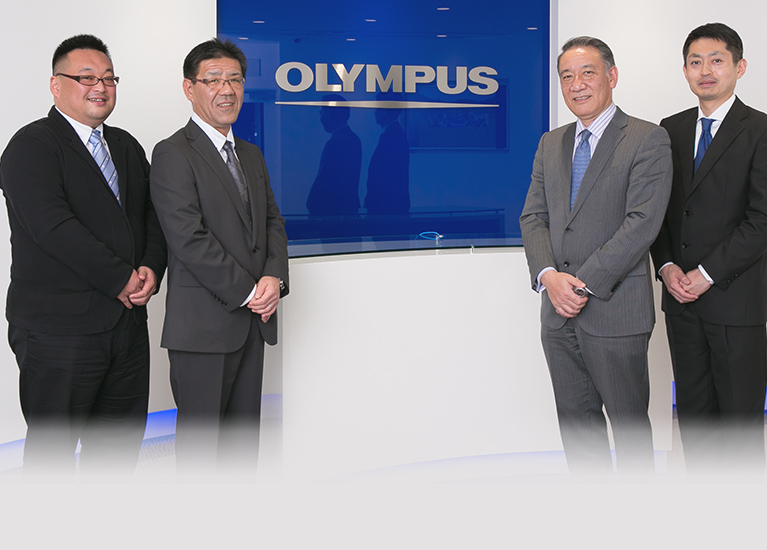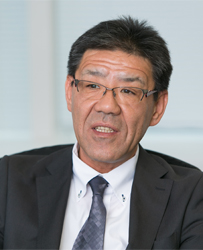

30% Inventory Reduction by utilizing ForecastPRO & SynCAS PSI Visualizer
Since stockout leads to loss of opportunity while excess inventory may lead to financial loss, planning and practicing a balanced ideal PSI (Production, Sales, and Inventory) while trying to improve customer satisfaction and financial structure have been considered a challenge in most companies. Olympus Corporation, a global optical instrument manufacturer, addressed this challenge by applying a quantity-adjusting “global integrated PSI system”.
They started a SCM reform project to link the PSI construction process ranging from sales planning to production planning in a coordinated manner, and visualize, systematize, and standardize the PSI process in order to improve customer satisfaction, financial structure, and operations efficiency. In the “global integrated PSI system”, they used a demand forecasting support software “ForecastPRO” as the tool to forecast demand; and after verifying its accuracy, the production, sales, and inventory adjustment and inventory visualization solution “SynCAS PSI Visualizer” as the tool to monitor the inventory conditions. Adding these into the newly developed “global integrated PSI system” enabled Olympus to achieve highly accurate demand forecasting. Furthermore, they are achieving a reduction of around 30% in the amount of inventory at its head office since two years ago.

[Photo left] Mr. Hiroyuki Honmo, Business IT Promotion Dept., IT Div., Olympus Corporation
[Photo second from the left] Mr. Yoshihiro Yamada, Group leader, Science Service Dept., Scientific Solutions Div., Olympus Corporation
[Photo second from the right] Mr. Osamu Sadachi, General manager, Science Service Dept., Scientific Solutions Div., Olympus Corporation
[Photo right] Mr. Akira Kato, Team leader, Science Service Dept., Scientific Solutions Div., Olympus Corporation

Mr. Sadachi
Olympus started from the dream of its founder, Mr. Takeshi Yamashita, “to make a domestic microscope”. Mr. Yamashita founded Takachiho Seisakusho (current Olympus Corporation) in October 1919, and after just six months, the company introduced the microscope “Asahi”.
“Since then and until today, the company has produced and sold a great variety of microscopes as a microscope manufacturer, and we, in the science business, are the successors of the founder’s DNA.” says Mr. Osamu Sadachi, General manager of the Science Service Dept.
Science business comprises five product areas. The main product areas are that of microscopes that help researchers aiming at the state-of-art in bioscience, or help to control quality at production sites, that of remote visual testing instruments to inspect the interior of airplane engines and large-scale plant pipes for cracks and corrosion, and that of non-destructive inspection equipment used for maintenance and inspection of social infrastructure facilities such as oil pipelines and power plants.
It has production sites centered in Japan and North America, and its sales network covers Japan as well as the world: Asia, Europe, Americas, and Oceania. Olympus provides products and solutions optimal to professionals (pathologists, researchers, inspectors, etc) in each region to contribute to the safety, security, and health of people around the world.

Mr. Yamada
“Manufacturers capable of providing great microscopes in the world are limited. For this reason, our most important mission is to not run out of stock and meet delivery dates for customers and markets.” stresses Mr. Sadachi.
Most products are stocked as finished products because Olympus is often required to respond swiftly to needs of universities, research departments, medical facilities, private manufacturing departments, etc. Ensuring delivery dates is a commitment to customers, and very important from the viewpoint of SCM. This was addressed by maintaining a stock of finished products. However, excess inventory puts pressure on profits. So, the management was strongly requesting inventory adjustment to strengthen financial structure.
“In response, we started a global SCM reform project to pursue both improved customer satisfaction and inventory adjustment, which resulted in the construction of our global integrated PSI system “GIPS”, a system designed based on ideas from all concerned people.” says group leader Mr. Yoshihiro Yamada explaining the reasons of the global integrated PSI system.
Production should be planned based on accurate demand forecasting; however, demand forecast and planned sales may be set with values that differ from the actual demand as they include targets and expectations of sales people and management. Moreover, since there were no tools to check the accuracy of these different demand data, the PSI decision making process was a kind of black box. Also, in theory, sales planning and production planning should be closely related. However, human involvement were making both processes a chunk of black boxes that depended on “intuition” and “experience”, a far cry from visibility.
“Even if suspicious about figures in the planned sales submitted by each sales department, there was no way to logically point out where problems were, whether there were inherent issues, or why they didn’t make sense. So, people in charge of production and sales adjusted production every day, were based on intuition and experience. In this way, it was impossible to fulfill management requests.
For this reason, we decided to visualize the sales planning process to see why such figures were drawn. The tool we chose was ForecastPRO. It was not used to improve the accuracy of the forecast but to clarify the deviation between planned sales and actual sales created by ForecastPRO from past data. In this way, we managed to clarify the expectation of sales people and management, as it showed which region deliberately added how many units of which model.
In addition, we visualized the production planning process by setting the optimal number of units per model to retain in stock calculated from past actual sales. This enabled us to eliminate most black boxes from the planning process, making the PSI decision making process visible.
We managed to standardize the global PSI process so that it draws the same figure for everybody. We finally managed to eliminate the “intuition” and “experience” put in by the people in charge of production and sales, and improve operations efficiency as well as visualize the global PSI process.” adds Mr. Sadachi.

The objective of the SCM reform project was to construct a “global integrated PSI system”, a system to visualize PSI (P: production, S: sales, I: inventory) and plan production based on optimal quantity in stock and demand forecast by using various statistical methods.
To achieve the objective, a demand forecasting tool based on a clear statistical logic and a tool to visualize inventory and make operations efficient were required. After comparing and studying a number of tools available domestically, Olympus decided for products provided by Hitachi Solutions East Japan: the demand forecasting support system “ForecastPRO” as the tool to forecast demand, and the production, sales, and inventory adjustment and inventory visualization solution “SynCAS PSI Visualizer” as the tool to visualize inventory.
“We participated in a seminar, and there we were convinced that they were adequately providing the features we were looking for.” speaks Mr. Yamada appreciatively of both products.
“We thought that they were unique products. Their logic was simple and easy-to-understand. They were reasonable also from the viewpoint of cost and were risk-free. Expensive products cost hundreds of millions of yen.” acknowledges Mr. Sadachi.
Olympus started constructing the system after verifying the feasibility of “ForecastPRO” for a few months using existing data, and confirming its high level of accuracy.

Mr. Honmo
The global integrated PSI system started operation in July 2014. “ForecastPRO” is charged with S (Sales) for sales planning, while “SynCAS PSI Visualizer” is charged with I (Inventory) for inventory visualization. In addition, by using a BI (Business Intelligence) tool, SCM data and financial data are simultaneously made available to the concerned people for checking to speed up the decision making. The necessary actual results data is downloaded from the core system to make graphs of inventory and other necessary actual results so that monitoring is easy to everyone.
Campaign information from sales departments and new product development information from development departments are also imported to update the supply (production) plan sequentially using the latest demand forecast.
“The mechanism to level for P (Production), planned production, is a system developed in house. Until now, leveling was carried out manually, at factories, by spending much time. However, with this system, the planned production per day is automatically calculated based on the planned production for the next month and the leveling conditions at the relevant factory, and transferred to Nagano Plant.” explains Mr. Hiroyuki Honmo of the Business IT Promotion Dept., IT Div.
“For I (Inventory), we are leveraging SynCAS PSI Visualizer. The number of items managed with SynCAS PSI Visualizer amounts to around 3000 for both microscopes and remote visual testing instruments. We assume an inventory for the next three months, and if a stockout, that is, “exceeding the lower limit” within three months is probable, an alert e-mail is sent out to people in charge of PSI. In response, we request the factory(factories) to either adjust the schedule or increase production. In other words, the point is how fast and efficiently we can make decisions regarding quantity adjustment against a number of items exceeding the limit of manageability by individuals and frequent needs for increasing/reducing production. SynCAS PSI Visualizer is also contributing to the reduction of overtime and prevention of human errors.” says Mr. Sadachi.

Mr. Kato
The global PSI system achieved outstanding results in about one year of operation.
“Percentage error rate is 22.2% in the microscope area and 33.6% in the remote visual testing instrument area. So, we are achieving an accuracy of approximately 70 to 80% in total.” says Mr. Yamada with a smile.
Though excess stock was left for the next step, the global integrated PSI system is steadily compressing the inventory.
“Moneywise, we successfully managed to compress the head office inventory by 30% in approximately one year”. (Mr. Yamada)
In addition, production planning was standardized, halving the required man-hours.
“Until now, production planning depended on individual experience and abilities. However, as we managed to eliminate the human factor by systematization, we are completing the tasks, which used to take 30 days, in 7 days. The time saved is used to train inventory analysts as well as to carry out inventory analysis and inventory adjustment promotion activities.” says team leader Mr. Akira Kato, speaking about the results.

In Step 1, the use of the global integrated PSI system was limited to sales forecasting and inventory control in the head office. However, the company had sales and stock all over the world.
“From now on, we will deploy the global integrated PSI system around the world. We have already started working, and we believe that we’ll be able to get greater results.” states Mr. Yamada, speaking confidently of the future development.
Lastly, when asked for advice to companies perceiving demand forecasting and inventory adjustment as challenges, Mr. Sadachi concluded as follows:
“In the manufacturing industry, we have a large number of “costs” to do business, such as fixed assets used in production plants, parts for production, and finished goods. The point is, how to efficiently and effectively sell to convert these “costs” into cash.
For that, I believe that the decision making process must be visible and backed by data as much as possible. Demand forecasting and sales planning tend to be expectations of the management. But my understanding is that it is important to not produce based on the expected demand forecast, but to follow a production plan based on a demand forecast visualized by using a wide variety of actual results data and statistics, as well as recent market data. In any event, what’s important is the sales planning process.
Here, the point is to create a sales plan (quantity x price) in accordance with a management plan based on the S&OP (Sales & Operations Planning) concept, and created by using a visible business planning process. In other words, what’s important is the process to create a visible and reasonable production plan without waste by understanding the deviation between the sales expected by the management and execution plan created by ForecastPRO.
Thereafter, adjust production as appropriate based on deviation analysis by qualitative PSI monitoring (PSI Visualizer).
I believe that it is necessary to have a logic to explain to the management by clarifying and systematizing (standardizing) the relationship among all planning processes, and a mechanism that draws the same result for everybody.
We managed to construct a highly polished system from affordable options and we are very grateful for that to Hitachi Solutions East Japan”.

|
Company Name |
Olympus Corporation |
|---|---|
|
Established |
October 12, 1919 |
|
Head Office |
Shinjuku Monolith, 3-1 Nishi-Shinjuku 2-chome, Shinjuku-ku, Tokyo 163-0914, Japan |
|
Paid-in Capital |
124.5 billion yen (As of March 31, 2017) |
|
Number of Group Employees |
34,687 (As of March 31, 2017) |
|
Business Description |
Manufacture and sales of precision machineries and instruments |